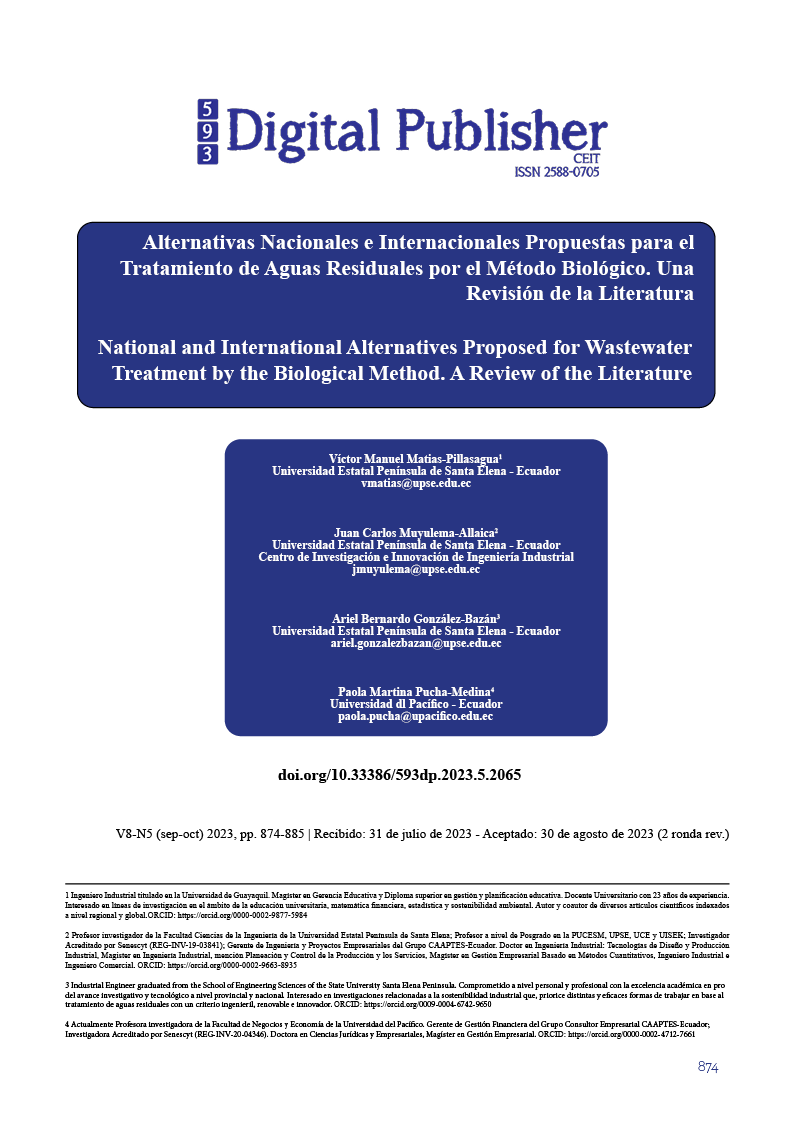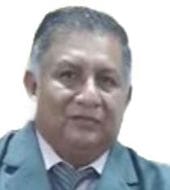Alternativas Nacionales e Internacionales Propuestas para el Tratamiento de Aguas Residuales por el Método Biológico. Una Revisión de la Literatura
Contenido principal del artículo
Resumen
Uno de los mayores desafíos en el mundo es lograr la minimización de la contaminación ambiental por medio de las aguas residuales, por ello, la aplicación de distintos métodos biológicos para tratar aguas residuales va a ser de gran necesidad en un futuro. El presente estudio tuvo como objetivo dar a conocer los distintos métodos biológicos para tratar aguas residuales, además de demostrar la eficiencia que puede lograr obtenerse mediante la aplicación de estos métodos. La metodología que se utilizó para la obtención de información se realizó mediante la aplicación de la revisión sistemática de la literatura (RSL) y la evaluación de la calidad de la información (AMSTAR II), con el fin de obtener información válida y actualizada sobre los métodos de tratamientos biológicos para aguas residuales. Se efectuó un análisis sobre los distintos porcentajes obtenidos en los tratamientos biológicos mostrados, así mismo, se presentó en breve las limitaciones de la investigación. Por último, se pudo concluir que los tratamientos biológicos de aguas residuales muestran altos índices de eliminación y degradación de los componentes existentes en los efluentes aplicados.
Descargas
Detalles del artículo

Esta obra está bajo una licencia internacional Creative Commons Atribución-NoComercial-CompartirIgual 4.0.
1. Derechos de autor
Las obras que se publican en 593 Digital Publisher CEIT están sujetas a los siguientes términos:
1.1. 593 Digital Publisher CEIT, conserva los derechos patrimoniales (copyright) de las obras publicadas, favorece y permite la reutilización de las mismas bajo la licencia Licencia Creative Commons 4.0 de Reconocimiento-NoComercial-CompartirIgual 4.0, por lo cual se pueden copiar, usar, difundir, transmitir y exponer públicamente, siempre que:
1.1.a. Se cite la autoría y fuente original de su publicación (revista, editorial, URL).
1.1.b. No se usen para fines comerciales u onerosos.
1.1.c. Se mencione la existencia y especificaciones de esta licencia de uso.
Citas
Alviano, A. R., & Andriyono, S. (2020). Wastewater Treatment on Shrimp Processing Industry. Journal of Marine and Coastal Science, 9(3), 139. https://doi.org/10.20473/jmcs.v9i3.22296
Cabrera, M., Montenegro, L., & Jiménez, A. (2022). Análisis de un Sistema de Tratamiento de Aguas Residuales de una Industria de Embutidos. Revista Politécnica, 49(2), 47–54. https://doi.org/10.33333/rp.vol49n2.05
Cai, Y.-H., Galili, N., Gelman, Y., Herzberg, M., & Gilron, J. (2021). Evaluating the impact of pretreatment processes on fouling of reverse osmosis membrane by secondary wastewater. Journal of Membrane Science, 623, 119054. https://doi.org/10.1016/j.memsci.2021.119054
Carrizo, D., & Moller, C. (2018). Estructuras metodológicas de revisiones sistemáticas de literatura en Ingeniería de Software: un estudio de mapeo sistemático. Ingeniare. Revista Chilena de Ingeniería, 26, 45–54. https://doi.org/10.4067/S0718-33052018000500045
Chen, H., Chen, Z., Zhou, S., Chen, Y., & Wang, X. (2023). Efficient partial nitritation performance of real printed circuit board tail wastewater by a zeolite biological fixed bed reactor. Journal of Water Process Engineering, 53, 103607. https://doi.org/10.1016/j.jwpe.2023.103607
Chen, Y., Lin, M., & Zhuang, D. (2022). Wastewater treatment and emerging contaminants: Bibliometric analysis. Chemosphere, 297, 133932. https://doi.org/10.1016/j.chemosphere.2022.133932
Ciapponi, A. (2018). AMSTAR-2: herramienta de evaluación crítica de revisiones sistemáticas de estudios de intervenciones de salud. Evidencia, Actualizacion En La Práctica Ambulatoria, 21(1). https://doi.org/https://doi.org/10.51987/evidencia.v21i1.6834
del Angel, E., Pantoja, M. A., López, R., & Cruz, A. E. (2022). Treatment of domestic wastewater using activated carbon prepared from sugarcane bagasse. Tecnología y Ciencias Del Agua, 13(1), 144–183. https://doi.org/10.24850/j-tyca-2022-01-04
Dong, G., Chen, B., Liu, B., Cao, Y., de Jourdan, B., Stoyanov, S. R., Ling, J., Ye, X., Lee, K., & Zhang, B. (2022). Comparison of O3, UV/O3, and UV/O3/PS processes for marine oily wastewater treatment: Degradation performance, toxicity evaluation, and flocs analysis. Water Research, 226, 119234. https://doi.org/10.1016/j.watres.2022.119234
González Fragozo, H. E., Zabaleta Solano, C., Devia González, J., Moya Salinas, Y., & Afanador Rico, O. (2020). Efecto del riego con agua residual tratada sobre la calidad microbiológica del suelo y pasto King Grass. Revista U.D.C.A Actualidad & Divulgación Científica, 23(2). https://doi.org/10.31910/rudca.v23.n2.2020.1513
Hamatani, Y., Watari, T., Hatamoto, M., Yamaguchi, T., Setiadi, T., & Konda, T. (2023). Greenhouse gas reduction of co-benefit-type wastewater treatment system for fish-processing industry: A real-scale case study in Indonesia. Water Science and Engineering. https://doi.org/10.1016/j.wse.2023.03.001
Hang Pham, T. T., Cochevelou, V., Khoa Dinh, H. D., Breider, F., & Rossi, P. (2021). Implementation of a constructed wetland for the sustainable treatment of inland shrimp farming water. Journal of Environmental Management, 279, 111782. https://doi.org/10.1016/j.jenvman.2020.111782
Iturralde Jácome, X. A., & Hernández Escobar, A. A. (2022). Biofiltración de aguas residuales de industrias arroceras de San Jacinto de Yaguachi, Ecuador mediante cascarilla de arroz. Revista Iberoamericana Ambiente & Sustentabilidad, 5, e271. https://doi.org/10.46380/rias.vol5.e271
Muloiwa, M., Dinka, M., & Nyende-Byakika, S. (2022). Modelling the biological treatment process aeration efficiency: application of the artificial neural network algorithm. Water Science and Technology, 86(11), 2912–2927. https://doi.org/10.2166/wst.2022.388
Pérez, Y. A., García Cortés, D. A., & Jauregui Haza, U. J. (2022). Humedales construidos como alternativa de tratamiento de aguas residuales en zonas urbanas: una revisión. Ecosistemas, 31(1), 2279. https://doi.org/10.7818/ECOS.2279
Pizarro, A. B., Carvajal, S., & Buitrago-López, A. (2020a). Assessing the methodological quality of systematic reviews using the AMSTAR tool. Colombian Journal of Anesthesiology. https://doi.org/10.5554/22562087.e913
Pizarro, A. B., Carvajal, S., & Buitrago-López, A. (2020b). Assessing the methodological quality of systematic reviews using the AMSTAR tool. Colombian Journal of Anesthesiology. https://doi.org/10.5554/22562087.e913
Raj, S., Singh, H., & Bhattacharya, J. (2023). Treatment of textile industry wastewater based on coagulation-flocculation aided sedimentation followed by adsorption: Process studies in an industrial ecology concept. Science of The Total Environment, 857, 159464. https://doi.org/10.1016/j.scitotenv.2022.159464
Ramos, R., & Navarro, A. (2020). Tratamiento de efluentes del cultivo de Seriola lalandi por sedimentación, filtración y absorción en diferentes tiempos de retención hidráulica. Revista de Biología Marina y Oceanografía, 54(3), 297–307. https://doi.org/10.22370/rbmo.2019.54.3.2020
Roque, F., Delgado, D., Chirinos, B., Huanca, R., Alvarez, E., & Medina, R. (2021). Diseño Sostenible De Un Módulo Innovador De Tratamiento Biológico De Aguas Residuales En Comunidades Rurales Andinas Vulnerables Utilizando Nostoc Commune Caso: Coporaque-Caylloma (Perú). Proceedings of the 19th LACCEI International Multi-Conference for Engineering, Education, and Technology: “Prospective and Trends in Technology and Skills for Sustainable Social Development” “Leveraging Emerging Technologies to Construct the Future.” https://doi.org/10.18687/LACCEI2021.1.1.582
Sgroi, M., Gagliano, E., Vagliasindi, F. G. A., & Roccaro, P. (2020). Absorbance and EEM fluorescence of wastewater: Effects of filters, storage conditions, and chlorination. Chemosphere, 243, 125292. https://doi.org/10.1016/j.chemosphere.2019.125292
Shabanizadeh, H., & Taghavijeloudar, M. (2023). A sustainable approach for industrial wastewater treatment using pomegranate seeds in flocculation-coagulation process: Optimization of COD and turbidity removal by response surface methodology (RSM). Journal of Water Process Engineering, 53, 103651. https://doi.org/10.1016/j.jwpe.2023.103651
Shea, B. J., Reeves, B. C., Wells, G., Thuku, M., Hamel, C., Moran, J., Moher, D., Tugwell, P., Welch, V., Kristjansson, E., & Henry, D. A. (2017). AMSTAR 2: a critical appraisal tool for systematic reviews that include randomised or non-randomised studies of healthcare interventions, or both. BMJ, j4008. https://doi.org/10.1136/bmj.j4008
Shende, A. P., & Chidambaram, R. (2023). Cocoyam powder extracted from Colocasia antiquorum as a novel plant-based bioflocculant for industrial wastewater treatment: Flocculation performance and mechanism. Heliyon, 9(4), e15228. https://doi.org/10.1016/j.heliyon.2023.e15228
Tang, X., Fan, C., Zeng, G., Zhong, L., Li, C., Ren, X., Song, B., & Liu, X. (2022). Phage-host interactions: The neglected part of biological wastewater treatment. Water Research, 226, 119183. https://doi.org/10.1016/j.watres.2022.119183
Waqas, S., Harun, N. Y., Bilad, M. R., Samsuri, T., Nordin, N. A. H. M., Shamsuddin, N., Nandiyanto, A. B. D., Huda, N., & Roslan, J. (2022). Response Surface Methodology for Optimization of Rotating Biological Contactor Combined with External Membrane Filtration for Wastewater Treatment. Membranes, 12(3), 271. https://doi.org/10.3390/membranes12030271
Xie, J., Zou, X., Chang, Y., Xie, J., Liu, H., Cui, M., Zhang, T. C., & Chen, C. (2023). The microbial synergy and response mechanisms of hydrolysis-acidification combined microbial electrolysis cell system with stainless-steel cathode for textile-dyeing wastewater treatment. Science of The Total Environment, 855, 158912. https://doi.org/10.1016/j.scitotenv.2022.158912
Ye, T., Li, M., Lin, Y., & Su, Z. (2023). An effective biological treatment method for marine aquaculture wastewater: Combined treatment of immobilized degradation bacteria modified by chitosan-based aerogel and macroalgae (Caulerpa lentillifera). Aquaculture, 570, 739392. https://doi.org/10.1016/j.aquaculture.2023.739392
Zhang, C., Yang, X., Dai, J., Liu, W., Yang, H., & Bai, Z. (2023). Efficient extraction of phenol from wastewater by ionic micro-emulsion method: Anionic and cationic. Chinese Journal of Chemical Engineering, 58, 137–145. https://doi.org/10.1016/j.cjche.2022.11.003
Zhang, Y., Li, M., Zhang, G., Liu, W., Xu, J., Tian, Y., Wang, Y., Xie, X., Peng, Z., Li, A., Zhang, R., Wu, D., & Xie, X. (2023). Efficient treatment of the starch wastewater by enhanced flocculation–coagulation of environmentally benign materials. Separation and Purification Technology, 307, 122788. https://doi.org/10.1016/j.seppur.2022.122788





